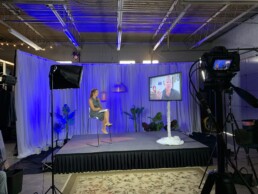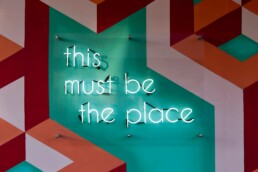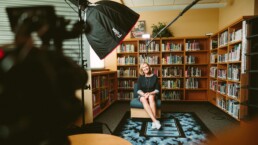25 Ways to Inspire and Elevate Your Events Program
David Saef, the Chief Instigator in Freeman’s strategic advisory practice, shares his expertise in event organization and corporate marketing in a post-pandemic world. In his interactive webinar, Saef explores 25 ways to implement strategies that will inspire and elevate your event programs, whether it be in-person, online, or a combination of both. While his 25 reasons cleverly served as an acronym for “Leading Through Uncertaintyâ€, Saef successfully cultivated a safe, welcoming space to learn how to best navigate through the changes in the industry. Here are a few takeaways from the session, click here if you would like to watch the recorded session for all 25.
“Not Your Old Floor Planâ€
Being the most requested topic of the 25, Saef explained how traditional floor plans had to seriously change in order to make the most of both the space and the participants. Floor plans are commonly planned within a structured grid. However, due to circumstances of the pandemic, such as limited guests and health regulations, Saef suggested the industry move towards Area Zones. These zones are geared towards allowing people to safely share by community based on interest within the event. Area Zones prioritize time and audience needs.
“Gamified!â€
Guests also inquired how gaming can affect a digital event and exhibitor success. In general, we saw a positive outlook when incorporating gaming, with a 45% and 12 min increase in exhibitor engagement. However, it was noted that companies need to choose who and when these tactics are utilized for. For example, investing into gaming tactics with a more entry-level crowd will not be as efficient compared to a more experienced crowd.
“Touchless Immersionâ€
The pandemic has placed multiple restrictions on what an experience entails. With Touchless Immersion, we can create our own picture, transporting guests into a new environment. This option is not only cost efficient, but would be truly memorable for everyone involved. The examples provided included a room evolved into the painting “Aterlier de Lumieres†and another room immersed into a pattern created by artist Yayoi Kusama.
“Designing for Intentâ€
Saef notes that the pandemic may often have us asking “How can I make my on-site, online?â€. However, no matter how many times you ask yourself this question, it’s the wrong way of thinking. He suggests to not forcefully convert all our work to online, but instead that by doing less, and doing it better, we can find an equilibrium with doing both online and on-site events. For example, content curation will better help choose what should be delivered to certain audiences.
“Delivery Mattersâ€
As we move toward online, it is important to recognize how someone presents themselves on screen. Some suggestions for creating a successful online presence includes a smile, adequate headroom, alignment with the top third of the screen, and including your elbows. To create more lively communication, include body movement using your hands and upper body.
Saef reminds us of the importance of taking breaks. Whether it be escaping to your safe haven, walking through nature, or having a coffee break, we all need to take a breather. By having the goal of uplifting others, we are creating an environment where we can all thrive.
The Changing Role of Meeting & Event Planners
“The industry has changed more these past 6 months than ever in our lives,†our very own CEO, Tim O’Malley has stated. NHS Global Events President Sean Lynch, Michelle Durpetti Events Chief Planner Michelle Durpetti, and Huron Consulting Group Meetings & Events Manager Matthew Bohn share their thoughts on virtual events, pricing, and tips for future or current event planners during this difficult time. Want to watch the full video on our Youtube channel, just click here.
All four professionals agree that hybrid models are not going to end anytime soon. So, how do we generate excitement using hybrid models? Lynch says the key is to broadcast these events by using production value. This includes assets such as lighting and sound that were crucial before the pandemic.Â
Now, It’s important more than ever for an event to have fluidity and simplicity. “Remember it’s about the audience, the right content in front of the right people,†states Bohn. A useful tactic used by Huron Consulting Group during a virtual event is to incorporate a Q&A in the live chat. They also create polls that will keep the audience engaged.
Another question you may ask is, “how to lay out the experience†virtually. For example, in a gala if there was a certain meal, beverage or gift that would be provided in-person, that same commodity can be enjoyed virtually and sent out through the mail.
In terms of pricing and business appeal, “everyone’s budgets have been slashed,†states Bohn. He mentions how important it is to work within budgets during this time. Lynch says to not be discouraged, “event planners are still worth the hours they put in.†He emphasizes to be proud of your product and the services you’re selling. Lastly, one aspect of business appeal mentioned by all the professionals is the need to have clear and updated websites.
During this time it’s necessary to continue learning & cultivating communication, working on professional development and leveraging strengths.
Career Search Success Strategies for Hospitality, Tourism, and Events Industries
Interview Like an Expert President, Lynée Alves helps those in need of career tips and strategies. Alves is a professional career expert and has focused on recruiting, interviewing, and hiring for more than 20 years. Here is her advice on topics such as current challenges, resumes, LinkedIn, interviews, and mindset.
It’s no secret that career search has become even more challenging due to COVID-19. There’s more competition, a rise of resume filtering software, and higher rates of unemployment. Applying is just the first step in the job process, but Alves gives a list of tips that will help your resume stand out. Watch the webinar below, or click here to watch on our Youtube channel.
Your resume must be in an updated format and layout with a sans serif font. You need a clear header that includes your LinkedIn URL and a professional summary, that highlights your key strengths and skills. “The most important part of your resume is the top half,†says Alves. When listing professional experience she advises to list responsibilities but to focus on your results and accomplishments. Additionally, job experience only needs to go back 20-25 years and if you have more than 15 years of work experience listing a graduation date is not necessary.
When discussing LinkedIn, Alves emphasizes the importance of professional social networking. Recruiters use LinkedIn Recruiter daily and look for potential employees. On your LinkedIn headline, you can write your job title plus key strengths and skills. The ‘About’ tab is the place to write about what makes you unique and interesting in what you do. You can also make an ‘open to opportunities†tab with the type of job you're looking for and make it public for recruiters to see. Alves advises to have regular activity on LinkedIn and to ideally have 500+ connections. Posting and sharing content on LinkedIn will help you become more visible.
Interviewing can be nerve-wracking, but Alves ensures research and practice can help make a difference. Always visit the company website and learn the role you’re applying for. Focus on soft skills which are characteristics that showcase your teamwork and communication capabilities. If you’re nervous, create a cheat sheet, practice out loud, and study interview questions that can be found online. If you’re interested in a career pivot, Alves advises focusing on your professional experience and what’s most transferable in similar roles.
Alves says the secret weapon is the mindset. “You attract what you put into the world.†Focus on positivity, your strengths, and be confident in yourself and your work experience. You can join Alves’s Facebook group if you’re looking for additional resources.
Written By: Marla Chavez Garcia
Live events may always have our heart, but virtual helps us smile right now
Things just aren’t easy now, for pretty much everyone. Sometimes it’s even tough to think about all the ways we used to be able to get together and connect only a year ago... And that’s just the baseline these days. We’re not trying to bum anyone out here, but we think about this stuff.
Lately, if anything funny or cool or interesting does happen, it seems to be happening in the virtual world. Like, Shaq being too big for even virtual NBA bleachers. Or Shia LaBeouf smoking weed in his truck during the virtual Fast Times at Ridgemont High table read... The virtual world, and virtual events, feel light and fun right now, because they feel more natural. And to be honest, more safe. Maybe hybrid events will get there soon. We hope. But a packed convention hall is sadly not happening anytime soon.
In fact, one of the reasons we built Expo Pass was to help organizers get thousands of people into an event space as fast as possible -- not sitting in front of their webcams. Sure, we had ideas about how virtual events could change everything, but live events were king... Until the world made it clear that live events were in fact, not king… And we had our first freak out. And then we quickly decided to pivot -- to utilize the strong platform that we had already built for live events, to support virtual events in every form. Including a new attendee interface to spur engagement between attendees and sponsors/exhibitors. And we also added streaming, obviously.
The Expo Pass platform now gives organizers the power to plan events that might be live, hybrid, or virtual, and then decide on the right format whenever it feels right. The branded registration and check-in process stays the same, and everything organizers build in Expo Pass stays intact in any event format. So switching to virtual, or hybrid, or maybe even making the leap to live one day, becomes a no stress decision. Which is what we all need right now.
It’s hard to tell how everything is going to end up. But after a few months of this new normal, it’s clear that events still make sense. They can still be good fun. And maybe even make the day a little easier. And that’s what we want to be a part of. Now more than ever.
We would love to share some ideas and practices we have seen while helping hundreds of event planners produce virtual events. Our Zooms are always on, literally, and we’re here to help out in any way we can. To schedule a chat, please visit www.expopass.com/lets-talk.
Written By: The Expo Team
What You Need to Know About #HTSOnline
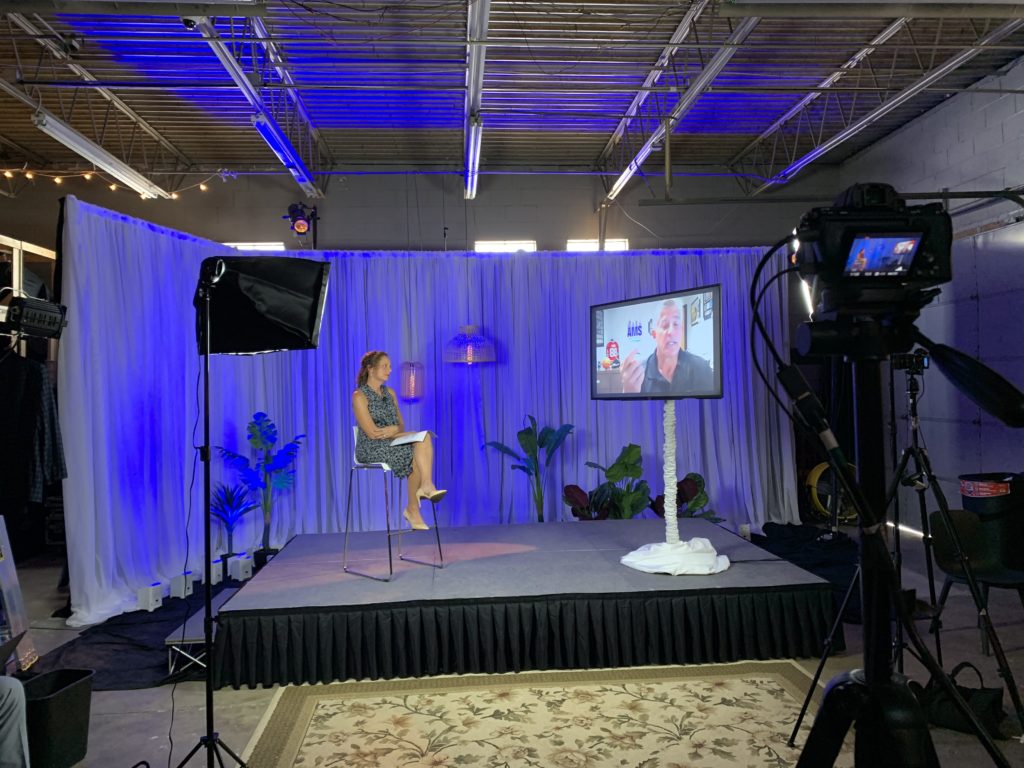
The Hospitality & Tourism Summit is coming at you completely online for its 19th annual year! So, what does that mean? How can a one-day trade show full of tangible experiences pivot to an online experience?
Ateema Media & Marketing, the producers of the summit, have worked hard over the last several months of quarantine to re-imagine the next best alternative. Dubbing this new format as the Hospitality & Tourism Summit Online, all attendees will have the ability to log on and log off at their leisure throughout the week.
The goal for the Hospitality & Tourism Summit is to bring together all industry friends after months of disconnect. The week is built for everyone to pick and choose their own pathway/schedule based on their interests, prior commitments, etc. Ateema has made this "pick and choose" format possible as they will be uploading the recordings of all of the webinars after they are presented live for attendees to watch on-demand. As well, attendees will have access to the trade show floor until next year's summit. They want all attendees to maximize their attendance but also be strategic with the programming you choose to attend live, because you can!
Keep on reading for some common misconceptions about the Hospitality & Tourism Summit Online and how you work around them:
Common Misconception #1: That you have to be online the entire week.
You do not! You can log on and log off based on what is on your personal agenda is each day. It is recommended that you choose a couple of opportunities to attend live each day. The summit has programming that is as short as 45 minutes. Even the longest sessions don't exceed 90 minutes.
Common Misconception #2: If you don't attend everything live, you won't be getting your ticket's worth.
So wrong! All educational sessions will be recorded and placed online for you to view at a later time that works better for you. The trade show floor will be live until April of 2021 so you can go back in at any time and keep browsing all of the exhibitor booths.
Common Misconception #3: Virtual networking is boring and awkward.
Not anymore! The Hospitality & Tourism Summit virtual networking events will be using a lifelike and user-friendly networking software that requires no prior setup on your part. Simply, click a link to enter the networking rooms, "walk-up" to any table, and join the conversation. If you aren't into the conversation or want to find some new people to talk to, leave the conversation just as easily! Live entertainment will also be provided during networking events.
Common Misconception #4: I am furloughed/out of work right now so this won't bring me value.
Switch your mindset! This is the PERFECT time for you to get involved if you are not currently working. At a time when many people in our industry are looking for solutions, trends, timely topics, and predictions for the future, you can say you were a part of those conversations! This is the time to invest in yourself.
CDC's Advice to Planners
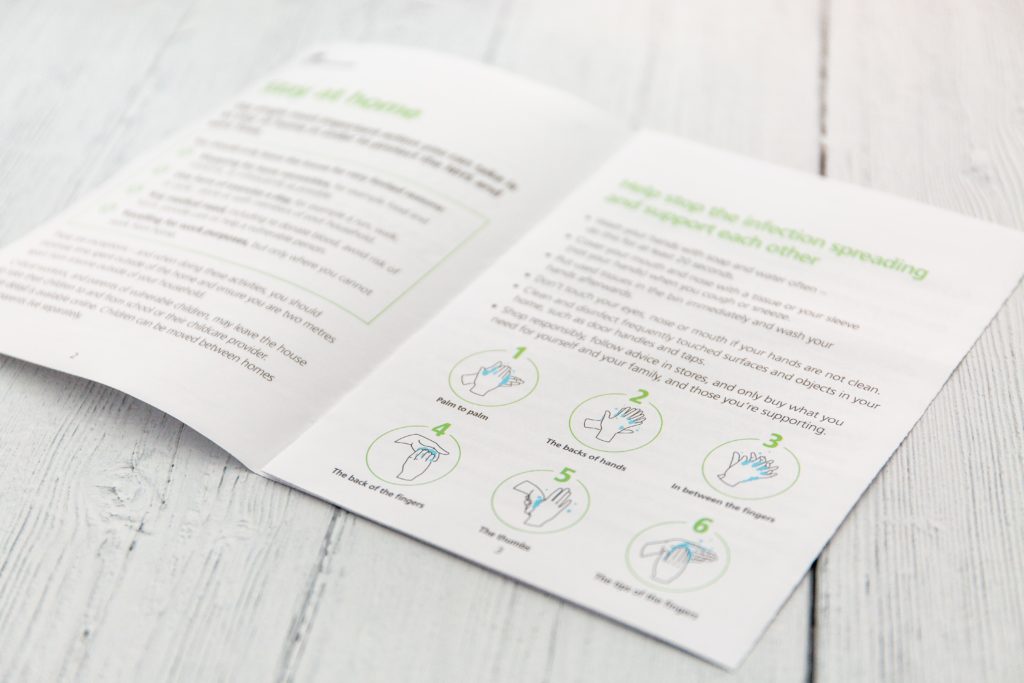
Meeting planners have been thrown a few curveballs over the past few months to say the least— from cancelled events and now new restrictions on in-person events. As we continue to adapt to COVID-19, it is crucial that meeting planners are up to date on the latest advice from the CDC in regards to hosting safe in-person events. We know you have many questions, and we are hoping to provide you with some answers based on guidance from the CDC.
How do you plan for an outbreak at an event?
The first step in planning an event in the COVID-19 era is by developing an emergency plan well before the event. The CDC recommends designating “an administrator or office to be responsible for responding to COVID-19 concerns. All staff and attendees should know who this person or office is and how to contact them.†Be sure to speak with local health officials about the event and have plans in place such as flexible refund policies for those who do not attend the event because they are not feeling well and plenty of supplies such as masks and hand sanitizer.
How do you prepare staff for the event?
Staff should be trained on all safety protocols. Virtual training is ideal to avoid contact with others, but if in-person training is necessary, make sure social distancing is possible. Consider using the CDC’s Interim Guidance for Businesses and Employers for guidance.
How many people can attend the event?
The CDC does not have a limit on how many people can attend an event, but be sure to check state and local policies on event capacity. Make sure there is plenty of space for event attendees to socially distance at all times, and consider an outdoor space as it is often easy to keep people spread apart and provides better ventilation than an indoor setting. Another way to limit the number of people at an event is by having entry times for staff and attendees.
Do attendees need to be tested for COVID-19 before the event or should their temperature be taken?
Testing all event attendees and staff is not recommended. Temperature screening and questionnaires asking attendees and staff if they have symptoms, have been in contact with anyone known to have the virus, or if they have travelled recently is recommended as long as it does not invade privacy.
How do you make sure attendees social distance at the event?
Hosting smaller events in larger spaces is one way to keep participants spread apart. It also helps to use designated entrances and exits to keep people from running into one another and use signs to indicate which direction guests should be walking. Avoid lines at places like bathrooms or registration areas. Techniques such as online check-in before the event can help to shorten lines and speed up the registration process. If lines are ever necessary, be sure to have signs and markings on the floor to remind people to keep six feet apart.
What can staff and attendees do to limit the spread of COVID-19 at the event?
Be sure that staff and attendees stay home if they are not feeling well as a first step in limiting the spread of COVID-19. Once at the event, be sure handwashing stations and hand sanitizer are easily accessible and that staff and attendees are utilizing these resources often. All staff and attendees should wear a face covering, especially it is not as easy to stay six feet apart from others.
What is the proper way to sanitize the event space before, during and after the event?
High touch surfaces such as door handles, sinks, drinking fountains and hand railers should be sanitized at least daily or as much as possible during the event. Other shared surfaces like countertops should be disinfected between uses. A cleaning schedule indicating what needs to be cleaned and when can help ensure that proper sanitation occurs during the event. EPA-approved disinfectants against COVID-19 should be used, but make sure there is proper ventilation so toxic vapors are not inhaled.
How do you safely distribute food at the event?
According to the CDC, “Avoid offering any self-serve food or drink options, such as buffets, salad bars, and drink stations. Consider having pre-packaged boxes or bags for each attendee.â€
What do you do if someone develops COVID-19 symptoms at the event?
Immediately separate anyone who develops symptoms at the event and provide them with clean disposable face masks. Close off all areas and disinfect anything the person with symptoms was in contact with. Contact local health officials about the potential case and be sure event attendees and staff are aware of possible exposure to COVID-19. Anyone who was in close contact with the potential case should also be separated.
How do I know if it is appropriate to cancel the event or not?
If the event space is not going to accommodate social distancing and it is not possible to find a larger space, it may be necessary to cancel the event or move the event online. If a large number of attendees are at higher risk of developing severe COVID-19 symptoms, it may be necessary to cancel or encourage these participants to not attend the event. If there is an outbreak in your community or in communities in which many attendees are coming from it may also be necessary to cancel. Ultimately, be sure to consult with local health officials when making this decision.
For more information, visit the CDC website.
Written By: Kelly Pawlak
How Hotels Can Appeal to Meeting Planners
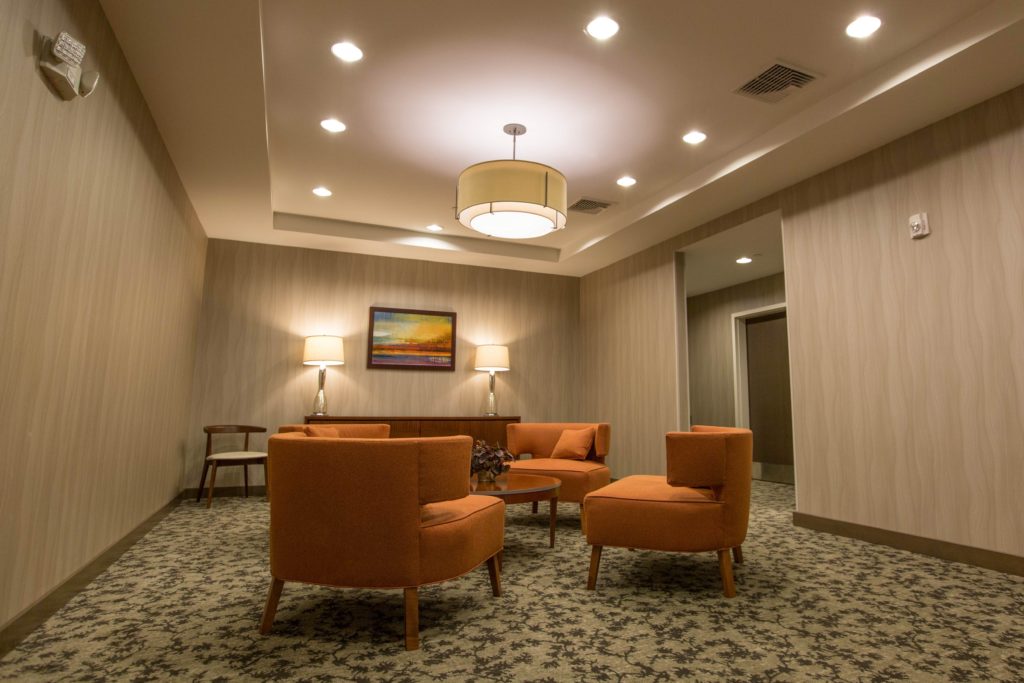
As the COVID-19 crisis continues and we adjust to this new normal, meeting planners are looking for spaces to safely host in-person events. In Lodging Magazine, VP of Product Development at Knowland Kristi White outlines what meeting planners want from hotels that are reopening.
Duty of care standards have a new level of importance to meeting planners than before. Whether a hotel has its own DOC standards or is following state regulations, these standards must be made clear to meeting planners. White emphasized that all hotel staff should be comfortable explaining these policies to guests and planners, and these policies should be easily accessible throughout the hotel and online.
Events are not going to be able to accommodate as many people as before, so as a hotel, it is important to follow local restrictions and requirements customers may have. “Prepare for a variety of options—whether six feet, seven feet, eight feet, or 12 feet of distancing,†White said.
Lower capacity in event spaces essentially means smaller events in larger spaces—potentially resulting in less revenue. White said it is important to work with the hotel’s revenue management team “to better understand how to price and optimize meeting space with the new social distancing guidelines.†A detailed plan for every scenario including room setup and number of rooms required will help sales teams sell events more seamlessly.
Self-serve buffets are not going to be seen at events in the near future, so hotels need to find ways to redesign banquet menus. In an article on Cvent, Megan Boley explains, “Seated dining could be an alternative option, if there are available staff members trained in sanitation and food-handling measures. These extra steps and layers of caution could tack on added cost to F&B, so it’s in the venues’ best interest to offer cost-effective solutions for food and beverage at events.†Pre-packaged meals and individually wrapped items are solutions to buffets, and White says these changes need to be clear in the hotel’s menu and pricing.
No matter what changes hotels make in preparing to host meetings, all changes and precautions must be clearly communicated to meeting planners and customers. Whether this be through email messages, a landing page, or creating an app for meeting planners and event attendees with safety information, all details should be easy to understand and access. White said creating an FAQ page and updating it as new questions come up is another effective way to communicate. It is just as important that sales teams are constantly updated on changes to effectively inform clients when selling events. As White said, “[planners] will want to book with hotels that have taken precautions and extra efforts to ensure their safety.â€
Hosting an event at your hotel may require more work than before, but luckily there are ways to safely and successfully host events at hotels during and beyond COVID-19.
Written By: Kelly Pawlak
Top 6 Tips for Adding Value

Call it a blessing in disguise but, meeting and event planners have gotten to use their creative side when hosting virtual programs. This has mainly come in the form of video conference systems like Zoom, Microsoft Meetings, Skype, and more. While a virtual event seems pretty straight forward, transferring a sponsor’s or attendee’s benefits to a virtual platform is maybe not-so-straight forward. In this article, we are going to give you our best tips for adding value to your stakeholders, a lot of which are from our very own Virtual Planner Master Class. This Master Class brought together some of the brightest minds in meeting and event planning to help discuss these issues and come up with some amazing solutions.Â
- Classes and tutorials: Online classes and tutorials offer great sponsorship opportunities and real value to event attendees. Things like cocktail mixing classes, cooking classes, or craft classes will allow your event to be more relaxed and provide real benefits to participants.Â
- Digital sponsor ad placement: While banners and physical sponsorship apparel may seem longer lasting attendees’ minds, online banners can still make a huge impression during webinars and virtual events. Staying as a static or changing montage of banners, these can bring in more value to sponsors and your event.Â
- Sponsor entertainment breaks: Many more online meetings and events have begun to utilize breaks in order to give attendees a chance to stretch their legs and grab another cup of coffee. During the break, you could host a small concert or another unique form of entertainment that could feature sponsors’ products and services. Or, simply have a screen with sponsor logo exposure that is displayed during the break with background music. This is an easy and fun way to build value around virtual events.Â
- Educational opportunities: A great way to retain sponsorship value in an event is simply by educating attendees through quick company overviews and how they relate to the topic at hand. Tying in a sponsor to your event’s overall theme or mission would allow them to stay even more relevant in the minds of your audience.
- Integrated chat features: Specialized chat room features during, in between, or after presentations can allow your event attendees to get more involved and actively participate with other members. This doesn’t only make meetings more fun, but it also builds a level of trust and participation among people who may be more apprehensive to network from behind a computer screen. Sponsors could also be added to this feature to bring in more value.Â
- Online games centered around rewards : Another great way to spend an online break or happy hour is to host games like trivia or team-building exercises. These will be sure to get everyone to relax more and increase participation among attendees. Sponsors could send out prizes to winners or create questions that are centered around their brands.Â
Written By: Colin Jay
Make Your Virtual Meeting or Event More Desirable
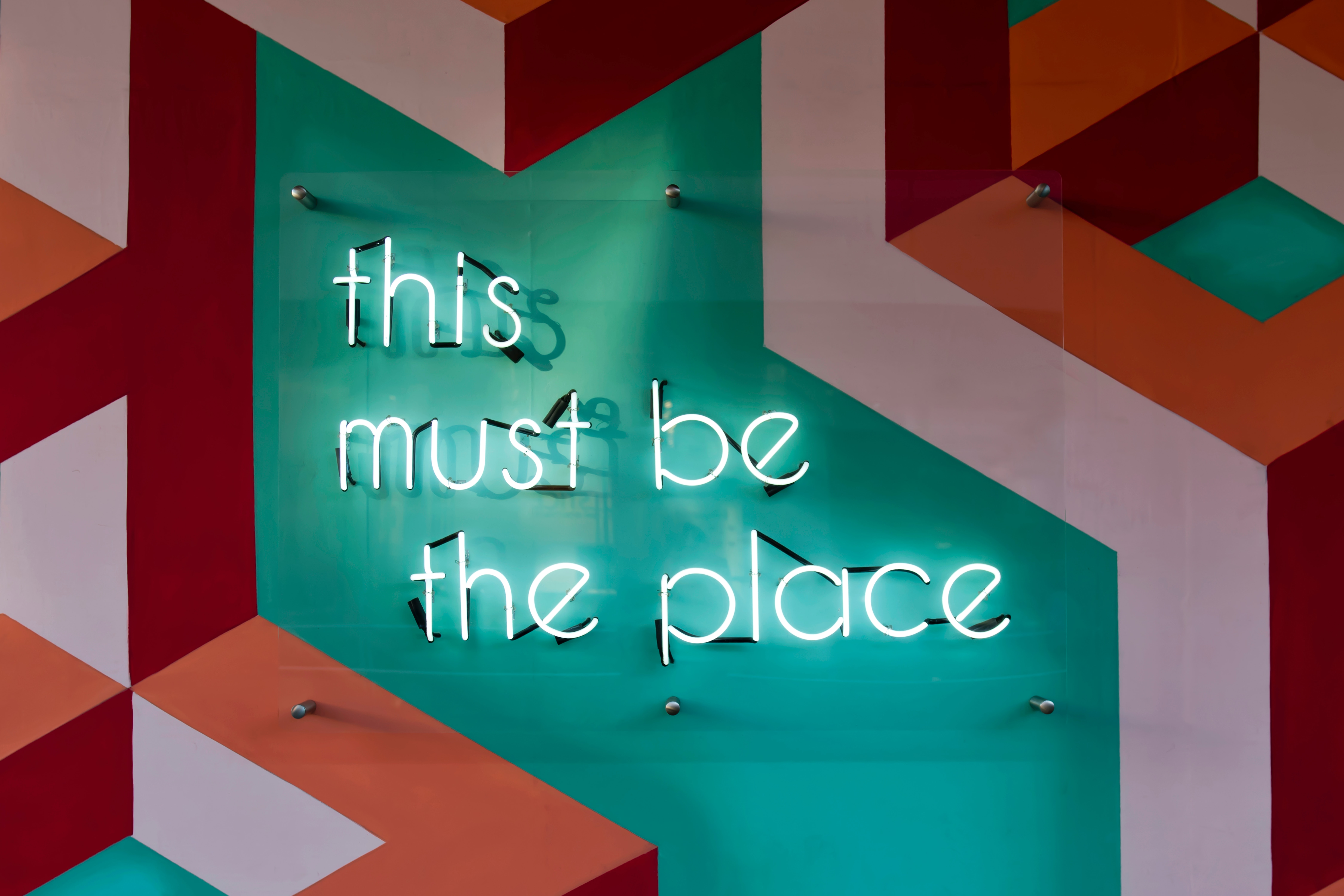
By now, anyone would be shocked to hear that someone has never attended a virtual meeting or event. But, we might not be so shocked to hear that “it was just ok†or “that could’ve been said in an emailâ€. We are finding that after months of moving events online, some are struggling to find ways to keep their content fresh and provide decent value to the attendees. It may require some out-of-the-norm thinking, but with proper use of technology and incorporation of quality education, a desirable and successful outcome is possible.Â
Technology is more important now than ever for hosting engaging meetings and events. However, we are finding that even the best of the best blue light blocking glasses can’t prevent “screen exhaustion†and “zoom fatigueâ€. It can be challenging to even know where to start when beginning to plan, so start with an informative and user-friendly event website. The event website should be a resource for potential attendees to learn about the event and register. The website can include the event itinerary and communicate to potential participants the value in attending the virtual event.Â
Pro tip for standing out: Be concise with the information on your website registration page. Someone should be able to figure out if this is a virtual meeting or event they want to attend within the first 60 seconds on your page. If your website is top notch, people will associate that with how your event will go.
Gaining participant interest and registration is an important first step, but keeping participants engaged with the use of technology once the event starts is even more important. So, sure the event team knows how to effectively use the technology. And if they don’t, hire someone! Nobody wants to join a virtual event and have to deal with the infamous “technical difficultiesâ€.
Pro tip for standing out: Make sure that there is powerful WiFi wherever the meeting, event, or presenter is streaming from. Although it would be nice in our personal lives to have a mute button, you don’t want a presenter’s mouth moving with the words lagging 2 seconds behind.
There are many new tools to provide a more “real†virtual experience. One of these being virtual reality. While this concept seems new to many of us, taking advantage of VR is not as difficult as it may seem. Give your attendees a tour of a museum or gamify a trade show floor using software. Take VR to another level by having event attendees create an avatar for themself that can walk around an event venue virtually to network or choose different breakout sessions they may be interested in.
Pro tip for standing out: Research new softwares or ways of live streaming. A screen share, although effective, is not always exciting anymore.
Since moving meetings and events online, it is a lot easier for an attendee to get up and walk away, or start working on something else. The point of your virtual meeting or event should not be to provide background noise to someone’s lunch hour. If that was true, our industry would be trending on Spotify Podcasts. Ultimately, you want engaged attendees that are learning something. If they feel as if they didn’t gain valuable knowledge, they will likely not be interested in attending future events with you. Try partnering with an educational institution or a highly valuable principal in the industry to add credibility to the event.
Pro tip for standing out: Not only does your educational speaker affect the quality of the event, but also the uniqueness of the content they share. People want solutions without having to read between the lines. Find someone who is able to speak on a different angle than attendees have maybe heard before.
Written By: Kelly Pawlak
Three Ways to Host Safe Events Now
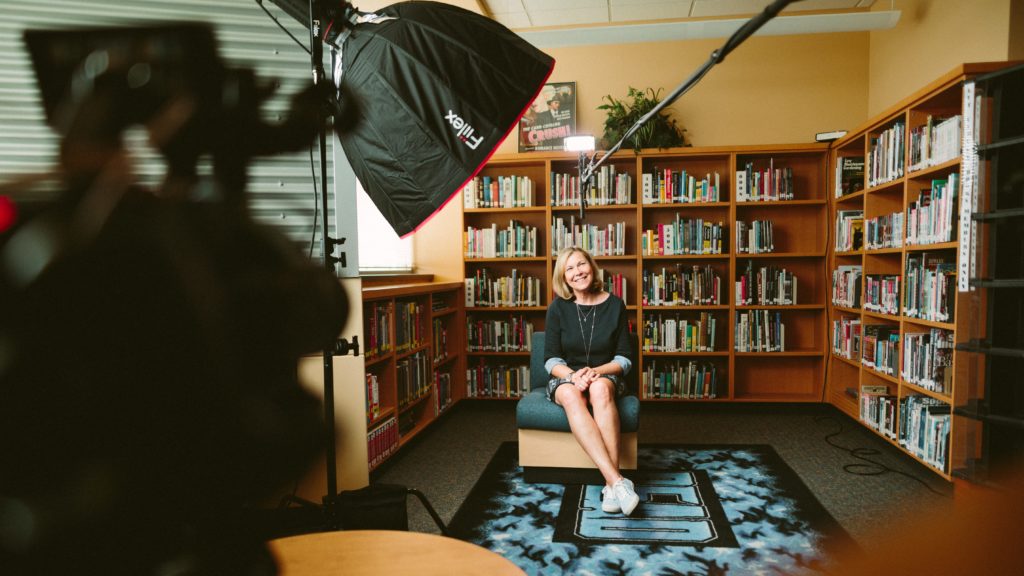
The events world has been shaken up for quite a bit now. As the industry progresses through the phases of reopening, there has been one common denominator: safety first...and that will likely be the new standard. Through remaining connected with our industry peers, we found that what almost everyone wants to know is “Of all the work-arounds due to COVID-19, which ones are here to stay forever?â€. Until the future of events unravels, here are three ways you can host an event now without compromising the safety of your stakeholders.
1. Try out a hybrid event
While virtual events aren’t going away anytime soon, a hybrid event might be the next stepping stone to ease people back into in-person events. Cannonballing into the pool of pre-COVID events might not set you up for success. Instead, you may find that doing a hybrid event, partially live and partially virtual, is a great way to dip your toes in. For instance, try having your presenter(s) broadcast live at a venue, yet keep attendee participation virtual.
At Virtual Planner Master Class, broadcasted live from The Old Post Office, the Ateema team hosted their event at a venue, just as one would for an in-person event. The main difference was that the presenters were speaking to the attendees through a room equipped with A/V broadcasting capabilities and their outfits included a mask as the finishing touch instead of a name badge. What didn’t change was the wow factor. Jamie Sowski, Marketing & Events Manager for The Old Post Office, was able to have a video production team pre-record their gorgeous and historic event space, play that video during the broadcast, and do a live voice-over just as if she was actually walking potential clients through the venue.
2. Think unconventionally when working with vendors
Okay, so you may not want to have a medieval-times-feast-style meal for safety reasons. However, that doesn’t mean you have to rule out catering. Whether your event is hybrid or strictly online, catering companies have plenty of creative ways for your attendees to indulge while also keeping them safe.
For virtual events, consider having boxed meals or DIY cooking kits delivered to attendees’ homes. This way, you are bringing the “IRL†factor while eliminating the potential for others (not equipped with PPE and lawfully required to meet sanitization standards) to come in contact with the food. To turn it into a hybrid event, consider broadcasting from a kitchen or bar with a live demo for the attendees to follow along with their goodie boxes delivered prior to the event.
Blue Plate Catering hosted a happy hour after Virtual Planner Master Class where they showcased their deliverable, seasonal offerings, and encouraged attendees to GYOB (grab your own beverage) while watching a mixologist demo their “sealed-with-safety†margaritas.
3. Design strategically for maximum comfort
In addition to the type of hybrid event we mentioned earlier, there are other ways to host a hybrid event. One of those ways is to allow a limited number of attendees to experience the event live with the event host and presenter(s). But before you go crazy with sending out these VIP invites, you need to envision the event design and event flow for maximum safety and respectively, maximum comfort.
So, how can you grab a venue that permits the ability to socially distance with ease? An answer to this question is outdoor events...bring your guests outside to the openness and fresh air. Or, opt for a large venue. Long gone are the days when a venue says “we've squeezed 100 people in a 500-square-foot room beforeâ€. Rooms with spacious floor plans are going to be better received by skeptical guests. It creates a feeling that their personal space is not threatened.
Also, give every guest a way to display their level of comfortability without the awkward do-we-hug-or-do-I-just-wave-hello moment. Support a local printer and create stickers with comical sayings like “Can’t Touch This†or “Free High Fivesâ€. When you create stickers for your attendees, don’t forget stickers for the floor...yes, you read that correctly. Having reminders on the floor that show people which way to walk and how far apart to stand is a great way to plan safe event flow and spatial comfort.
Written By: Emma McVady





